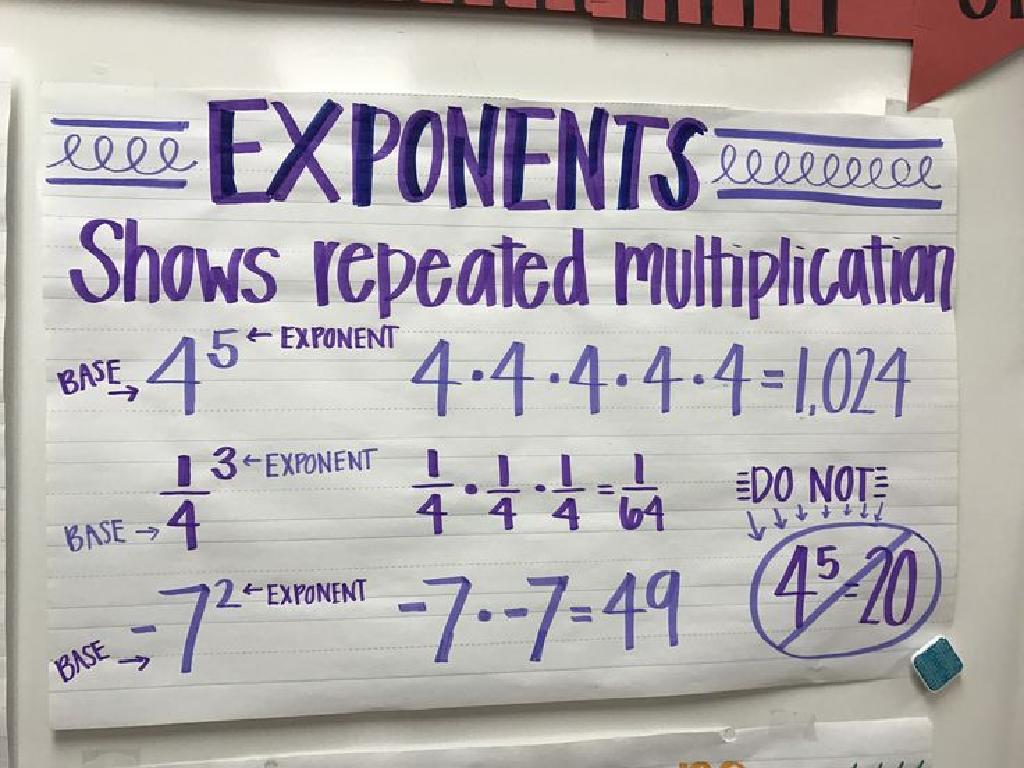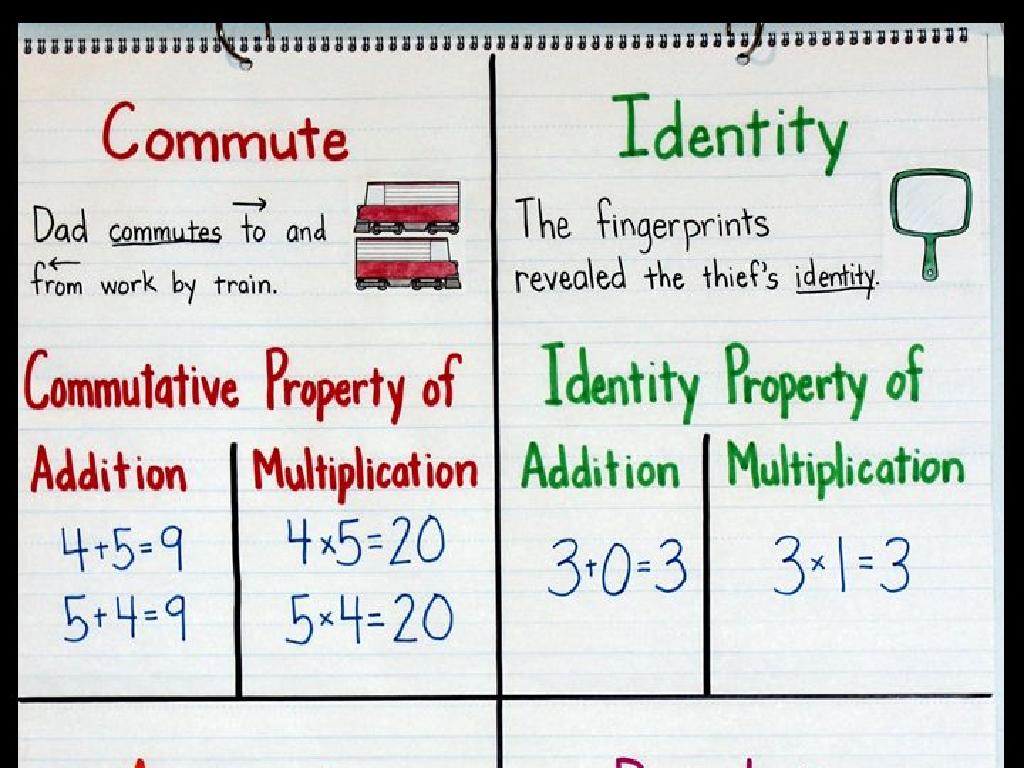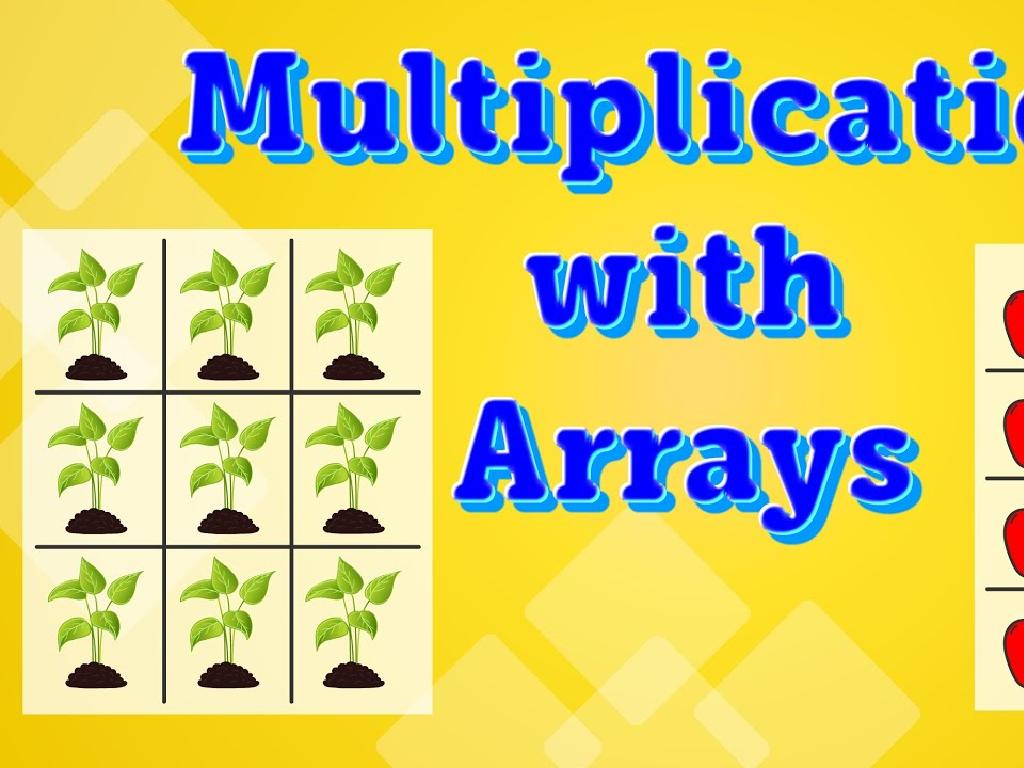Convert Decimals Between Standard And Expanded Form Using Fractions
Subject: Math
Grade: Fifth grade
Topic: Decimal Place Value
Please LOG IN to download the presentation. Access is available to registered users only.
View More Content
Converting Decimals to Expanded Form Using Fractions
– Place value’s role in decimals
– Each place has a value 10 times the place to its right
– Decimals represent parts of a whole
– A decimal like 0.3 means 3 tenths
– Converting decimals to fractions
– 0.3 is the same as 3/10 in fraction form
– Expanded form with fractions
– Write 0.3 as 3/10 to show its value in a fraction
|
This slide introduces the concept of decimal place value and its connection to fractions. Begin by explaining how each place to the left or right of the decimal point represents a power of ten. Emphasize that decimals are another way to express fractions, with the decimal places indicating tenths, hundredths, etc. Show students how to convert a decimal to a fraction by using the place value (e.g., 0.3 is 3 tenths, which is 3/10 as a fraction). Then, demonstrate how to write this in expanded form, breaking down the decimal into its fractional components. Use examples with different decimal places to illustrate the concept. Encourage students to practice with additional examples and provide guidance as needed.
Understanding Standard Form
– Standard form: common number writing
– Example: 3.47 is standard form
– Like how we normally see numbers
– Place value: each digit’s value
– 3 is in the ones place, 4 is in the tenths, 7 is in the hundredths
– Multiplying by 10 to the right
– Each step to the right, the place value divides by 10
|
This slide introduces the concept of standard form, which is the typical way of writing numbers using digits. For example, 3.47 is a number in standard form where 3 is in the ones place, 4 is in the tenths place, and 7 is in the hundredths place. It’s crucial to emphasize that as we move from left to right, each place value is ten times smaller than the previous one. This understanding is foundational for converting decimals to expanded form using fractions. Encourage students to practice with different numbers to solidify their grasp of place values in standard form.
Understanding Expanded Form with Decimals
– What is expanded form?
– It shows the value of each digit in a number.
– Breaking down decimal places
– Each decimal place value is separated.
– Example: Expanding 3.47
– 3 + 0.4 + 0.07 equals 3.47.
|
This slide introduces the concept of expanded form in the context of decimals, which is a way to express numbers by showing the value of each digit. It’s important for students to understand that each place value contributes to the overall number. For example, in the number 3.47, the 3 is in the ones place, the 4 is in the tenths place, and the 7 is in the hundredths place. When we expand the number, we write it as a sum of each digit multiplied by its place value. This helps students see the value of each part of the decimal number. Have students practice expanding different decimal numbers to reinforce the concept.
Fractions in Expanded Decimal Form
– Fractions represent decimals
– Example: 0.4 equals 4/10
– Four tenths is the fraction for 0.4
– Example: 0.07 equals 7/100
– Seven hundredths is the fraction for 0.07
– Write 3.47 as a sum of fractions
– 3.47 is 3 + 4/10 + 7/100 in expanded form
|
This slide aims to teach students how to convert decimals to fractions and use them in expanded form. Start by explaining that each decimal place value corresponds to a specific fraction. For instance, the tenths place is over 10, and the hundredths place is over 100. Show that 0.4 is the same as 4/10 because it is 4 tenths. Similarly, 0.07 is 7/100 because it is 7 hundredths. Then, demonstrate how to write a decimal like 3.47 in expanded form using fractions, breaking it down to 3 (whole number) + 4/10 (tenths place) + 7/100 (hundredths place). Encourage students to practice with different decimals to gain confidence in converting and expanding them using fractions.
Let’s Practice Together: Expanded Form with Fractions
– Convert 4.85 to expanded form
– 4.85 = 4 + 8/10 + 5/100
– Understand place value of digits
– 4 is in the ones place, 8 is in the tenths, 5 is in the hundredths
– Find fractions for decimal places
– 8/10 represents the tenths place, 5/100 for the hundredths
– Work as a team on conversion
|
This slide is an interactive class activity where students will convert the decimal number 4.85 into expanded form using fractions. Start by discussing the place value of each digit in the decimal, emphasizing the ones, tenths, and hundredths places. Guide the students to express each decimal place as a fraction: 8 tenths as 8/10 and 5 hundredths as 5/100. Then, combine these fractions with the whole number to write the number in expanded form. Encourage students to work together in small groups to reinforce the concept and to help each other understand the process. Provide additional examples if time allows and ensure to clarify any misconceptions.
Class Activity: Exploring Decimals
– Choose any decimal number
– Write the decimal in standard form
– Convert the decimal to expanded form
– Use fractions to show the value of each decimal place
– Discuss your findings with a partner
– Explain your conversion process to your partner
|
This activity is designed to reinforce the concept of decimal place value and the relationship between standard and expanded form using fractions. Students will select a decimal of their choice, ensuring a variety of examples in the classroom. They will practice writing it in standard form and then expand it, breaking down the decimal into its constituent parts using fractions to express the value of each decimal place. Afterward, students will pair up to explain their process and understanding to a partner, allowing for peer learning. As a teacher, circulate the room to assist and challenge students with different decimals. Possible activity variations include using dice to generate random decimals, converting expanded form back to standard form, or creating a gallery walk where students display and discuss their work.
Review and Reflect: Decimal Place Value
– Importance of decimal place value
– It helps in understanding the value of each digit in a decimal number.
– Expanded form and decimal comprehension
– Expanded form breaks down the decimal, showing the value of each digit.
– Converting decimals to expanded form
– Start with the whole number part, then expand each decimal place as a fraction.
|
Understanding decimal place value is crucial for students as it forms the foundation for working with decimals in all operations. It allows students to recognize the value of digits based on their position. Expanded form is a way to break down the decimal into its constituent parts, making it clearer how each digit contributes to the overall number. To convert a decimal to expanded form using fractions, begin with the whole number part, if any, and then express each decimal place value as a fraction (e.g., 0.3 as 3/10, 0.04 as 4/100), moving from left to right. This exercise reinforces the concept of place value and fractions, and it is a skill that will be used in higher-level math. Encourage students to practice with different decimals to gain confidence.
Homework Challenge: Decimals in Real Life
– Find items with decimal prices
– Write prices in standard form
– Convert prices to expanded form
– For example, $3.47 becomes $3 + 4/10 + 7/100
– Discuss your findings in class
|
This homework task is designed to help students apply their knowledge of decimal place value to real-world contexts. By finding items with decimal prices, students will practice identifying and writing decimals in standard form. They will then convert these decimals into expanded form using fractions, reinforcing their understanding of the relationship between decimals and fractions. Encourage students to bring in a variety of prices to discuss the different ways decimals can be expanded. This activity will also provide a foundation for understanding how to round and estimate decimal prices in future lessons.






